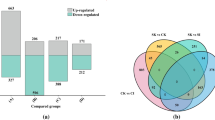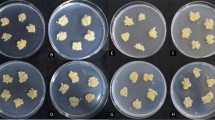Abstract
Small RNAs, especially microRNAs (miRNAs), play an essential role in the responses and adaptations of plants to many stresses, including salt stress. Characterizing miRNAs that correlate with salt stress will improve our understanding of salt tolerance and thus contribute to the sustainable production of maize. In our previous research, small RNA sequencing and degradome sequencing was performed on a maize inbred line (LH196), and many salt stress-responsive miRNAs and their targets were identified. In this study, the identity of target genes of miR164a was confirmed by quantitative expression analysis. Furthermore, the interactions between miR164a and its target genes were examined in a preliminary experiment using overexpression and target mimicry under salt treatment in maize. The results show that Zma-miR164 may respond to salt stress; because the expression of zma-miR164 was decreased with salt stress, leading to a significant increase in the expression of its target genes GRMZM2G114850 (the NAC transcription factor family proteins NAM, ATAF, and CUC) and GRMZM2G008819 (electron carrier). The NAC transcription factors respond to salt stress by regulating the expression pattern of their downstream genes.






Similar content being viewed by others
REFERENCES
Zhang, Y.F. and Yin, B., Advances in study of salt—stress tolerance in maize, J. Maize Sci., 2008, vol. 16, no. 6, pp. 83—85.
Zhang, B.H., Pan, X.P., Cobb, G.P., et al., Plant microRNA: a small regulatory molecule with big impact, Dev. Biol., 2006, vol. 289, no. 1, pp. 3—16.
Zhu, C., Ding, Y., Liu, H., MiR398 and plant stress responses, Physiol. Plant., 2011, vol. 143, no. 1, pp. 1—9.
Ruiz—Ferrer, V. and Voinnet, O., Roles of plant small RNAs in biotic stress responses, Annu. Rev. Plant Biol., 2009, vol. 60, no. 1, pp. 485—510.
Phillips, J.R., Tamas, D., and Dorothea, B., The role of small RNAs in abiotic stress, FEBS Lett., 2007, vol. 581, no. 19, pp. 3592—3597.
Kong, Y.Q.M., Elling, A.A., Chen, B.B., et al., Differential expression of microRNAs in maize inbred and hybrid lines during salt and drought stress, Am. J. Plant Sci., 2010, vol. 1, no. 8, pp. 69—76.
Cao, C., Long, R., Zhang, T., et al., Genome—wide identification of microRNAs in response to salt/alkali stress in Medicago truncatula through high—throughput sequencing, Int. J. Mol. Sci., 2018, vol. 19, no. 12, p. 4076.
Reinhart, B.J., Weinstein, E.G., Rhoades, M.W., et al., MicroRNAs in plants, Genes Dev., 2002, vol. 16, no. 13, pp. 1616—1626.
Lu, S.F., Sun, Y.H., Shi, R., et al., Novel and mechanical stress—responsive microRNAs in Populus trichocarpa that are absent from Arabidopsis,Plant Cell, 2005, vol. 17, no. 8, pp. 2186—2203.
Yao, Y., Guo, G., Ni, Z., et al., Cloning and characterization of microRNAs from wheat (Triticum aestivum L.), Genome Biol., 2007, vol. 8, no. 6, p. R96.
Subramanian, S., Fu, Y., Sunkar, R., et al., Novel and nodulation—regulated microRNAs in soybean roots, BMC Genomics, 2008, vol. 9, no. 1, p. 160.
Baev, V., Milev, I., Naydenov, M., et al., Implementation of a de novo genome—wide computational approach for updating Brachypodium miRNAs, Genomics, 2011, vol. 97, no. 5, pp. 282—293.
Pang, M., Woodward, A.W., Agarwal, V., et al., Genome—wide analysis reveals rapid and dynamic changes in miRNA and siRNA sequence and expression during ovule and fiber development in allotetraploid cotton (Gossypium hirsutum L.), Genome Biol., 2009, vol. 10, no. 11, p. R122.
Paul, S., Kundu, A., and Pal, A., Identification and validation of conserved microRNAs along with their differential expression in roots of Vigna unguiculata grown under salt stress, Plant Cell Tissue Organ Cult., 2011, vol. 105, no. 2, pp. 233—242.
Clepet, C., RNA captor: a tool for RNA characterization, PLos One, 2011, vol. 6, no. 4, р. e18445.
Riechmann, J.L., Heard, J., Martin, G., et al., Arabidopsis transcription factors: genome—wide comparative analysis among eukaryotes, Science (New York), 2000, vol. 290, no. 5499, pp. 2105—2110.
Nuruzzaman, M., Manimekalai, R., Sharoni, A.M., et al., Genome—wide analysis of NAC transcription factor family in rice, Gene, 2010, vol. 465, nos. 1—2, pp. 30—44.
Peng, H., Yu, X., Cheng, H., et al., Survey of plant NAC transcription factor family, Chin. Bull. Bot., 2010, vol. 45, no. 2, pp. 236—248.
Sun, L.J., Li, D.Y., Zhang, H.J., et al., The role of NAC transcription factors in plant disease resistance and abiotic stress response, Hereditas, 2012, vol. 34, no. 8, pp. 993—1002.
Fu, R., Zhang, M., Zhao, Y., et al., Identification of salt tolerance—related microRNAs and their targets in maize (Zea mays L.) using high—throughput sequencing and degradome analysis, Front. Plant Sci., 2017, vol. 8, p. 864.
Mou, G.P., Ji, C.Y., Xu, D.L., et al., Advances in plant miR164 family, Chin. Bull. Life Sci., 2013.
Sieber, P., Wellmer, F., Gheyselinck, J., et al., Redundancy and specialization among plant microRNAs: role of the MIR164 family in developmental robustness, Development, 2007, vol. 134, no. 6, pp. 1051—1060.
Guo, H., Xie, Q., Fei, J., et al., MicroRNA directs mRNA cleavage of the transcription factor NAC1 to down regulate auxin signals for Arabidopsis lateral root development, Plant Cell, 2005, vol. 17, no. 5, pp. 1376—1386.
Mao, W.H., Li, Z.Y., Xia, X.J., et al., A combined approach of high—throughput sequencing and degradome analysis reveals tissue specific expression of microRNAs and their targets in cucumber, PLos One, 2012, vol. 7, no. 3, p. e33040.
Kim, J.H., Woo, H.R., Kim, J., et al., Trifurcate feed—forward regulation of age—dependent cell death involving miR164 in Arabidopsis,Science, 2009, vol. 323, no. 5917, pp. 1053—1057.
Adam, H., Marguerettaz, M., Qadri, R., et al., Divergent expression patterns of miR164 and CUP-SHAPED COTYLEDON genes in palms and other monocots: implication for the evolution of meristem function in angiosperms, Mol. Biol. Evol., 2011, vol. 28, no. 4, pp. 1439—1454.
Li, C.H., Yin, Z.J., Liu, Y.D., et al., Differential expression of miRNA in different salt-tolerant cotton under salt stress, Shandong Agric. Sci., 2009, vol. 7, pp. 12—17.
Chen, L.J., Study on the effect of MicroRNA164 on the development and resistance of salt mustard, Master Thesis, Shandong Normal University, 2011.
Zhang, M., Liang, S., Hang, X., et al., Identification of heavy-ion radiation-induced microRNAs in rice, Adv. Space Res., 2011, vol. 47, no. 6, pp. 1054—1061.
Vialette-Guiraud, A.C.M., Chauvet, A., Gutierrez-Mazariegos, J., et al., A conserved role for theNAM/miR164 developmental module reveals a common mechanism underlying carpel margin fusion in monocarpous and syncarpous eurosids, Front. Plant Sci., 2015, vol. 6, p. 165.
Funding
This work was supported by the Key Research and Development Project of Jiangsu Province, China (Modern Agriculture, BE2017365), the State Key Laboratory of Crop Biology (Shandong Agricultural University) Open Fund (2016KF02), Scientific Research and Innovation Projects for Graduate Students in Jiangsu Province (KYCX20_2816), and the Practice Innovation Training Program Projects for College Students (2019084).
Author information
Authors and Affiliations
Corresponding authors
Ethics declarations
The authors declare that they have no conflict of interest. This article does not contain any studies involving animals or human participants performed by any of the authors.
Rights and permissions
About this article
Cite this article
Shan, T., Fu, R., Xie, Y. et al. Regulatory Mechanism of Maize (Zea mays L.) miR164 in Salt Stress Response. Russ J Genet 56, 835–842 (2020). https://doi.org/10.1134/S1022795420070133
Received:
Revised:
Accepted:
Published:
Issue Date:
DOI: https://doi.org/10.1134/S1022795420070133




